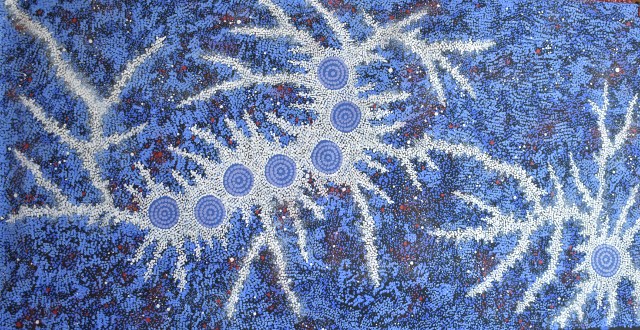
Why Songlines Are Important In Aboriginal Art?
Share
The songlines are the primeval tracks that zigzag around the Australian continent, serving as knowledge maps of the aborigines. These aboriginal songlines are not merely lines in a physical map, but the lines are multi-layered strings of narratives cloven afresh into songs, dances, ceremonies, and most importantly, aboriginal art. This blog post will take a closer look at the deep significance of songlines as a part of Aboriginal art and how this art form evolved to become the most important carrier of culture, law, and identity.

What Are Songlines?
Often described as "Dreaming tracks," what are songlines? They are lineages which follow tracks of creator beings across the landscape in the Dreaming (Tjukurrpa) - the Aboriginal Creation period. It was through these creatures that the world itself came into being, through song given names to animals, plants, rocks, and waterholes by these creatures, and it was through these creatures that the law and custom by which Aboriginals live was established.
Every songline can be described as a highly complex navigational system, a book of cultural law, and a spiritual map, connecting physical places with mythological narratives. These ancient paths echo in the songlines of indigenous people, creating a link between people and their country.
The Importance of Songlines in Aboriginal Art
Songlines represent the true art of the Aboriginals. They give the story, the form, and the soul to innumerable paintings. The art gives a visual representation to these pathways that are intricate and ancient.
Cultural and Spiritual Mapping
The Aboriginal songline is basically an advanced mapping of ancestral tracks and holy places. The visualization of these journeys, and stories in particular, through a rich lexicon of symbols and patterns is transferred through Aboriginal art so that the narratives, the ceremonies, and the physical sites can be remembered and recounted. Every dot, line, and form in a painting may support a particular attribute of the landscape or occurrence of the Dreaming.
Transmission of Knowledge
Songlines are huge libraries, inside which there is essential knowledge about which food to gather around, seasonal changes, water locations, animal habits, and survival tactics. Art is a priceless form of transmitting this knowledge across generations, not in written form. Complex information on ecology and social knowledge can be perceived in the complexities of a piece.
Spiritual Connection
The Dreaming tracks provide a strong spiritual bond among the Aboriginal people, their forebears, and the land. Art celebrates these relationships in the form of visual prayer or meditation that confirms the spiritual connection. The artist who paints a songline is not merely representing a narrative at all; he or she is joining its constant construction and force.
Identity and Belonging
Songlines play an important role in Aboriginal identity and belonging. They connect certain groups of people with definite locations and clans, determining their rights and duties toward a land. Works of art that have a songline pattern help to secure this identity and strengthen the bonds of the community, and is used as a symbolic key that defines a person and their origins.
Communication Across Regions
Common songlines are often shared by different groups of the Aboriginal languages, which has made it easier to communicate and exchange cultures over wide distances. The shared symbols and items in songlines Aboriginal art can be mentioned as a universal language of different communities, which understand the story and law of every community and can relate to it.
Songlines as Living Knowledge Systems
Songlines encompass much more than stories, such as endless details of knowledge and living systems. These include astronomy, ecology, etiquette, and ethics as to how society is supposed to relate to one another, as well as the land. All these songlines, Aboriginal systems, are constantly re-performed and reaffirmed by using ceremonies, songs, and visual art.
The Connection Between Songlines and Aboriginal Art
Aboriginal artists represent the visual image or songlines via the wealth of different symbols, patterns, and the methods of a story being told. The paintings on every canvas are not only songline paintings but also spiritual maps, and many times these maps portray the great journey of the ancestral beings, sacred places, and creation myths. This repetitive use of dots, lines, and concentric circles is a story, which is abstract and yet very personal to this rather custodial role of the artist.
In the Mandel Aboriginal Art Gallery, you will come across many instances of art that are directly linked to songlines. You may observe concentric circles that were symbolic of waterholes or ceremonial sites of great importance, travel lines showing the meat of the ancestral beings, and other aboriginal tracks (animal or human) showing direction and the presence of life. These are not simply random symbols, but they are constituents of a complex visual language directly connected with the songlines.
Artistic Interpretation: Visualising Sound and Story
Songlines become spectacular dot paintings and abstract pieces by Aboriginal artists. Movement, place, and narrative is communicated through the selection of colour, the consistency of the motifs, and the geometric accuracy of the artwork. A brilliant red may represent desert sands of some section of a songline, and detailed dot work can replicate the glitter of the heat or the tightness of the bush plum blooms.
That is where the Mandel Aboriginal Art Gallery can be seen as one of the places where these strong visual languages are brought to life. You can see here how artists such as those in the Utopia region act out their ancestral songlines, Aboriginal narratives in every brushstroke and dot, turning sound and narrative into real life, hypnotic songlines art.
Cultural Significance: Art as Law, Memory, and Identity
Aboriginal songline artwork is not just an aesthetic matter, but it has a deep responsibility, morals, and spiritual weight to it. They can be seen as memory aids and keep ancestral laws, relations, and rituals alive. Songlines artwork creation and exhibition usually comes with rights and permissions in place to further point to ownership and display, and the sacred nature of the knowledge they hold. When you view these works of art, you view a living culture.
The Seven Sisters Songline: A Continental Epic in Art
Among the most popular cases, there is the Songline of Seven Sisters. This is a strong example of a major continent-themed epic of how stories encoded in songlines spark the creation of artworks that trace creation narratives, moral teachings, and the subsequent crossing of many kinds of descendant beings over vast expanses of terrain.
The same hunt of the Seven Sisters (Pleiades star cluster) by the ancestral hunter Wati Ngintaka is portrayed in many variations of songline art, all of which are related to a part of this great narrative, all passing on particular laws and cultural protocols. These aboriginal songlines are works of art and are evidence of the timeless strength of the Dreamtime stories.
Why Preserving Songlines Through Art Matters Today
Nowadays, the role of indigenous art songlines in the preservation of songlines is more significant than it has ever been. These pieces of art make traditional expertise, language, as well as native cultural expertise stay alive and accessible in the fast-paced world. Mandel Aboriginal Art Gallery is one of the keys to this continuation of culture as it supports artists, grants a platform to a concert, and makes people learn about meaningful stories encoded in the art of songlines. This helps to maintain the strength of the songlines for future generations.
How to Read Songlines in Aboriginal Art
Understanding songline art requires a respectful approach. While specific interpretations are often restricted to initiates, you can still appreciate the deeper meaning by recognizing common motifs. Look for:
-
Dots: Often represent energy, spiritual power, or even the subtle textures of the land.
-
Tracks (Aboriginal Tracks): Can signify human or animal journeys, or even the movement of ancestral beings.
-
Concentric Circles: Frequently denote waterholes, sacred sites, meeting places, or ceremonial grounds.
-
Lines may indicate pathways, rivers, or the contours of the landscape.
By engaging with these visual elements or Aboriginal symbols and researching the stories behind them, you can begin to connect with the rich narratives embedded in Aboriginal tracks and the broader songlines Aboriginal framework.
Final Thoughts
The significance of songlines in Aboriginal art cannot be overestimated. They represent the walking blueprints of the Aboriginal culture and represent old laws, spiritual links, and great familiarity with the land. Aboriginal songlines can be heard even today through the colorful and elaborate works of the artists that make the audience see beyond the visual perception levels and experience the layers of manifestation in terms of creation, survival, and belonging that have been revealed through artwork and songlines by the Aboriginals over millennia.
Understand Songlines Through the Art at Mandel Aboriginal Art Gallery
Do you want to venture into the spiritual terrains and the ancient stories that are strung within songlines art? We also ask you to glance at the strength of these works with your own eyes. Go today and have a look at the Mandel Aboriginal Art Gallery (personally or through our online collection) and touch all that great art that was inspired by Aboriginal songlines.

